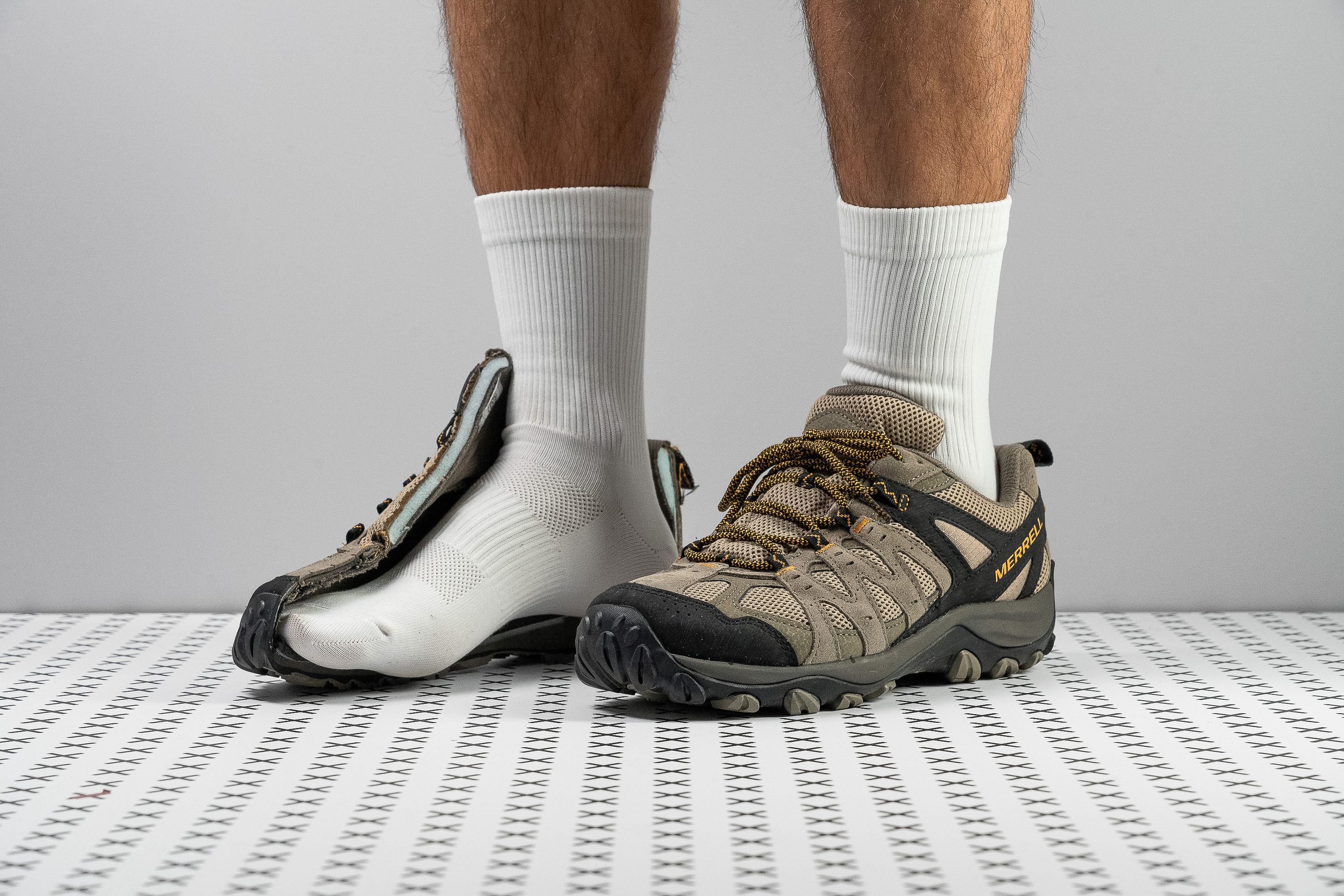Our verdict
- Top pick in best hiking shoes
- Top pick in best Merrell hiking shoes
Pros
- Stellar support
- Amazingly comfortable
- Performs well in the cold
- Can gobble up miles
- Versatile grip for moderate terrain
- Alleviates foot pain
- Fits like a glove
- Roomy and durable toebox
- Very easy to put on
- Budget-friendly
- Sustainably made
Cons
- Lackluster breathability
- Could be lighter
- Unruly laces
Audience verdict
Comparison
The most similar hiking shoes compared
+ + Add a shoe | |||||
|---|---|---|---|---|---|
| Audience score | 80 Good! | 75 Good! | 79 Good! | 89 Great! | |
| Price | $100 | $125 | $100 | $120 | |
| Trail terrain | Technical | Moderate | ModerateTechnical | Technical | |
| Shock absorption | Low | Low | Low | Low | |
| Energy return | Moderate | Moderate | Moderate | Moderate | |
| Weight lab Weight brand | 13.9 oz / 393g 14 oz / 397g | 12.9 oz / 367g 12.3 oz / 350g | 13.4 oz / 380g 13.4 oz / 380g | 15.3 oz / 434g 16.2 oz / 460g | |
| Lightweight | ✓ | ✓ | ✓ | ✗ | |
| Breathability | Warm | Breathable | Warm | Breathable | |
| Use | Day HikingBeginners | Day HikingBeginners | Day HikingBeginners | Day HikingBeginners | |
| Orthotic friendly | ✓ | ✓ | ✓ | ✓ | |
| Drop lab | 14.1 mm | 15.5 mm | 14.0 mm | 11.2 mm | |
| Size | True to size | Slightly small | True to size | True to size | |
| Midsole softness | Firm | Balanced | Firm | Firm | |
| Difference in midsole softness in cold | Small | Normal | Small | Normal | |
| Torsional rigidity | Moderate | Stiff | Moderate | Moderate | |
| Heel counter stiffness | Moderate | Moderate | Flexible | Flexible | |
| Stiffness | Flexible | Moderate | Flexible | Flexible | |
| Outsole hardness | Very hard | Average | Hard | Average | |
| Material | MeshSuede | - | MeshSuede | LeatherMesh | |
| Season | Winter | SummerAll seasons | Winter | SummerAll seasons | |
| Toebox durability | Very good | Good | Very good | - | |
| Heel padding durability | Bad | Decent | Bad | - | |
| Outsole durability | Decent | Decent | Decent | - | |
| Width / fit | Medium | Wide | Wide | Medium | |
| Toebox width | Medium | Medium | Medium | Medium | |
| Lug depth | 4.3 mm | 4.5 mm | 4.0 mm | 4.8 mm | |
| Heel stack lab | 30.8 mm | 34.4 mm | 30.6 mm | 31.7 mm | |
| Forefoot | 16.7 mm | 18.9 mm | 16.6 mm | 20.5 mm | |
| Widths available | NormalWide | Normal | NormalWide | NormalWide | |
| Technology | - | Ortholite | - | Vibram | |
| Heel tab | Finger loop | Finger loop | Finger loop | Finger loop | |
| Removable insole | ✓ | ✓ | ✓ | ✓ | |
| Ranking | #28 Bottom 20% | #32 Bottom 8% | #30 Bottom 14% | #7 Top 20% | |
| Popularity | #17 Top 49% | #12 Top 35% | #31 Bottom 11% | #1 Top 3% |
Who should buy
We recommend the Merrel Accentor 3 as a great choice for:
- Hikers looking for a comfortable shoe well-suited to longer treks to up their hiking mileage with
- Those in colder climates in need of a warm shoe that performs consistently no matter how low temperatures drop
- Hikers who prioritize strong grip and need a shoe that will provide reliable traction over a variety of surfaces
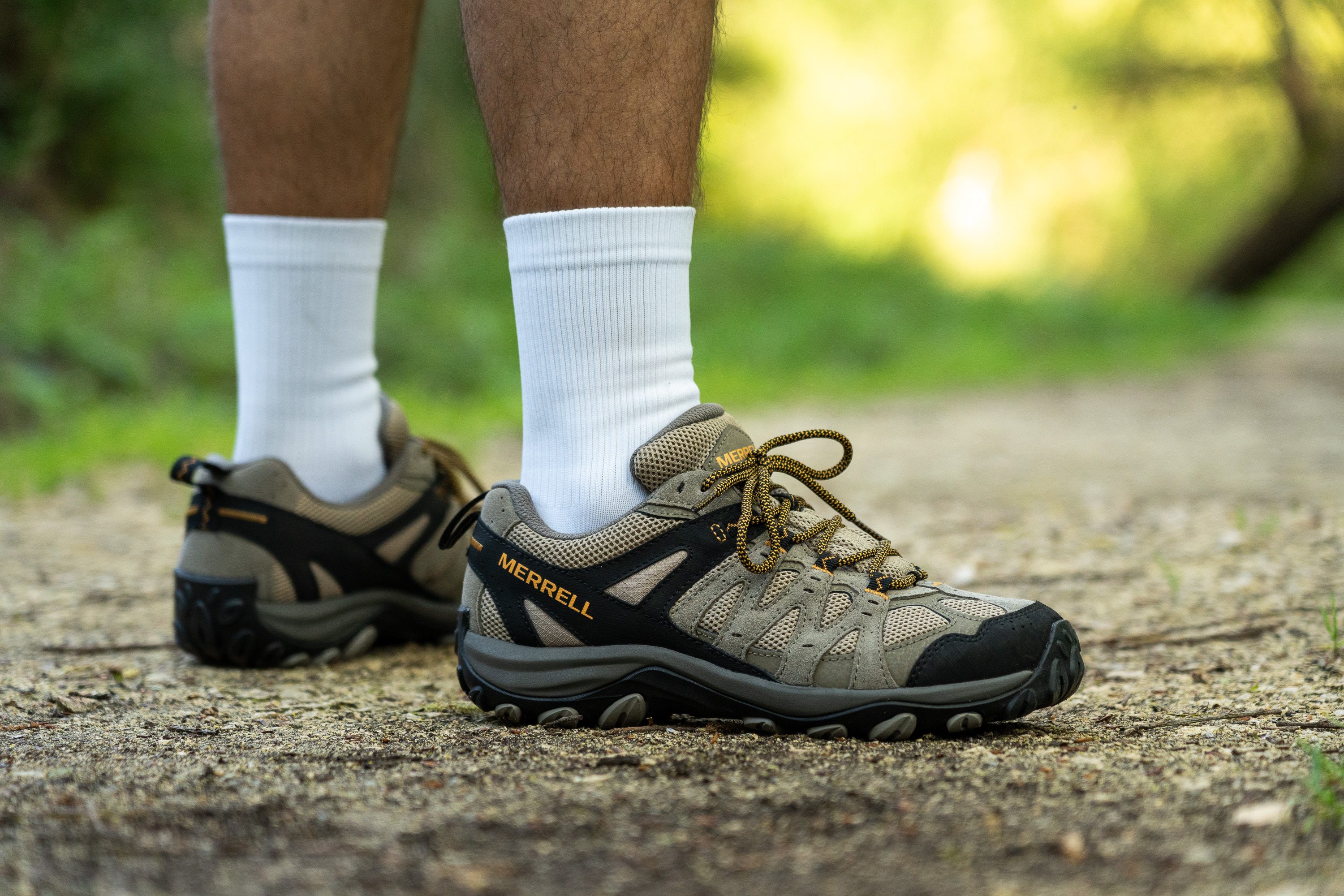
Who should NOT buy
Our smoke test reveals the Accentor 3 to suffer from a distinct lack of airflow. While this well-insulated nature makes it good for hikes in cooler weather, the shoe will feel like a foot sauna in the summertime. The KEEN NXIS Speed, on the other hand, has a much more breathable upper that is better suited to warm summer treks.
The Accentor 3's accommodating toebox might be a little too roomy for those with narrow feet. This will be especially apparent during steep descent where the toes will butt up against the toebox uncomfortably. For hikers in need of a more snug fit, we recommend checking out the Merrel Moab 3 an equally grippy and reliable alternative instead.
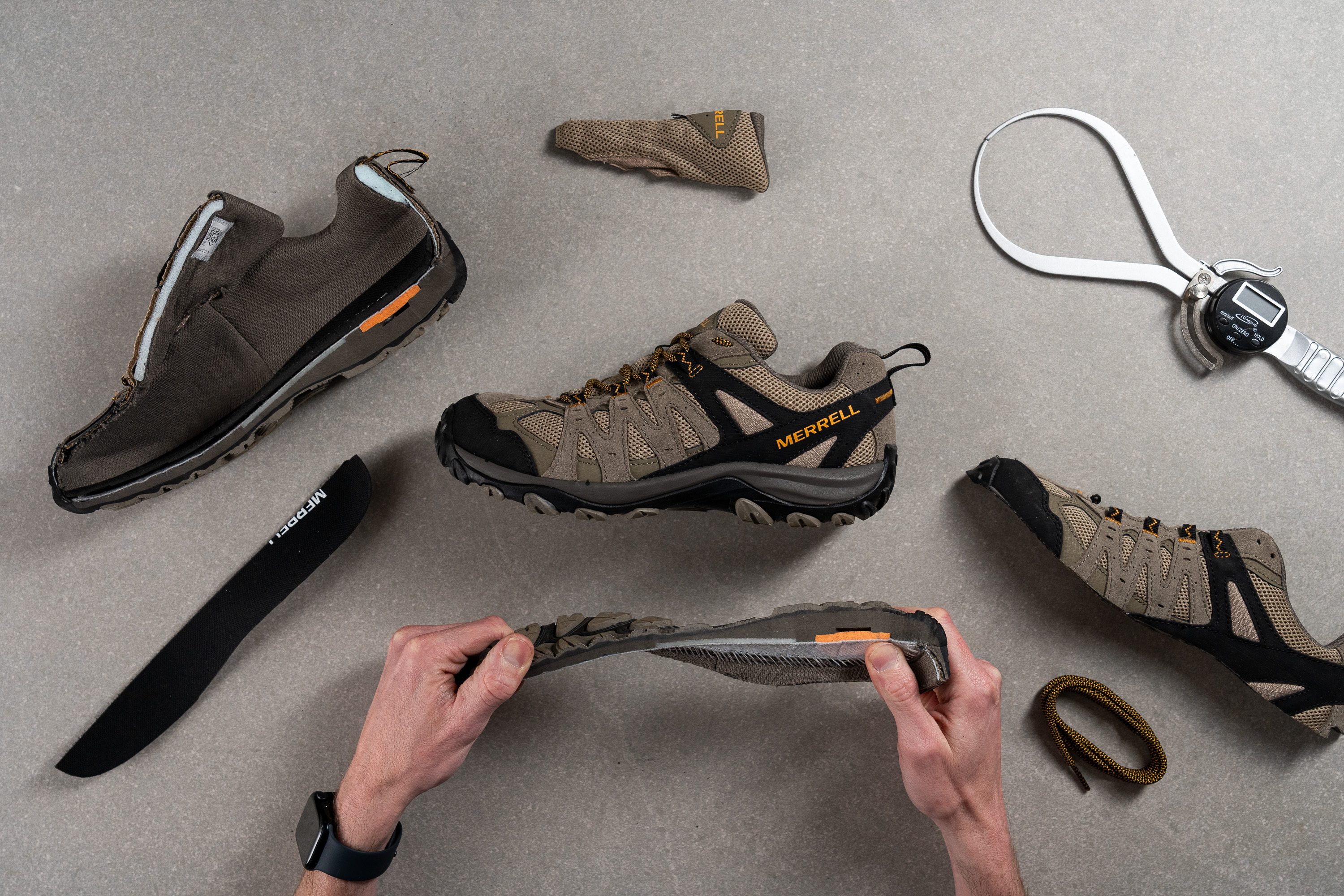
With the copious amount of rubber in its stack, the Accentor 3 is a relatively heavy hiking shoe. For those who prioritize a lightweight ride over versatile grip and want a shoe that can tackle some trail running, we recommend checking out the positively feathery Salomon Outpulse.
Cushioning
Shock absorption
Even with a special Air Cushion unit embedded into the shoe's heel, the Accentor 3's shock absorption proved to be only moderate at 95 SA.
But considering the price and purpose of this Merrell shoe (light-to-moderate day hikes), this is just right to provide sufficient comfort and impact protection.
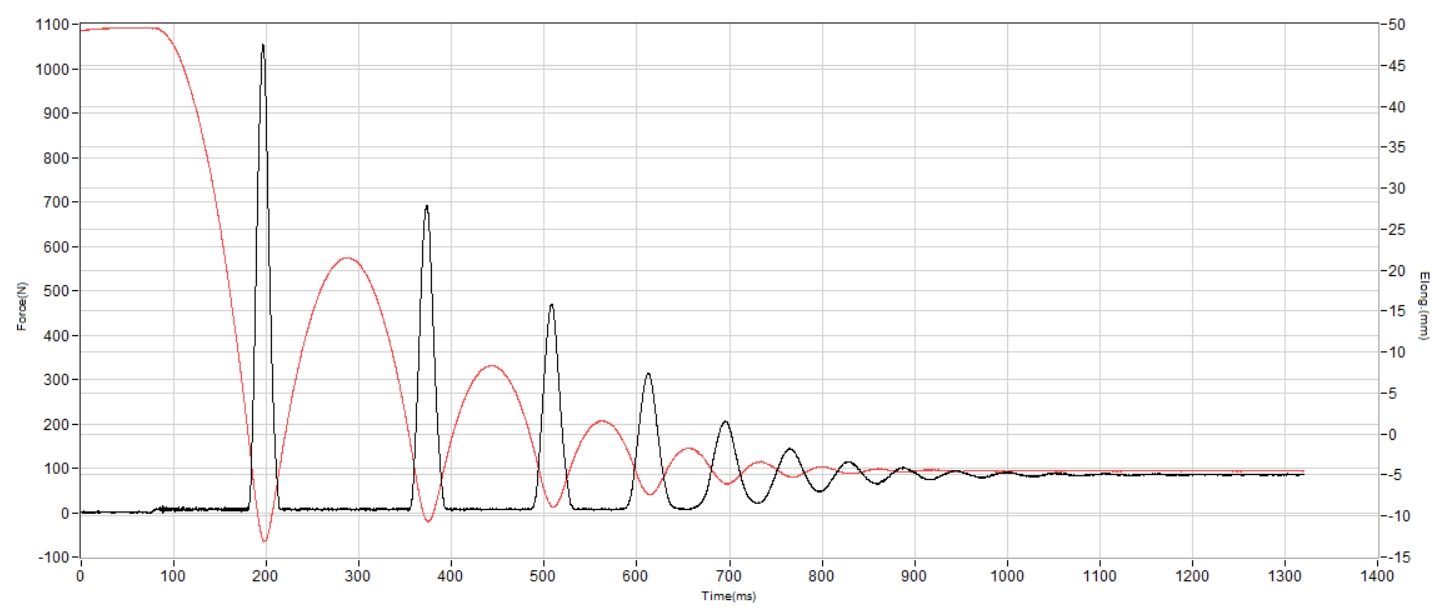
| Accentor 3 | 95 SA |
| Average | 104 SA |
Energy return
The Merrell Accentor 3 is decently responsive with a standard energy return of 51.3%. It's not enough to make it feel springy and bouncy but there is some rebound to keep the ride lively.
| Accentor 3 | 51.3% |
| Average | 50.2% |
Heel stack
We measured the Accentor 3's heel stack at 30.8 mm which is on par with our current lab average. This means enough foam and rubber to dampen our landings and protect our feet from harsh objects underfoot.

| Accentor 3 | 30.8 mm |
| Average | 32.8 mm |
Forefoot stack
Up at the forefoot, the Accentor 3's stack is shorter than average at 16.7 mm thick. As impact protection is less crucial in this part of the foot, this is a good enough buffer zone between us and the ground that still feels quite natural as we walk around.

| Accentor 3 | 16.7 mm |
| Average | 22.0 mm |
Drop
The difference in our stack measurements leaves the Accentor 3 with a drop height of 14.1 mm. This is a rather steep offset which indicates that our heel is much more elevated off the ground than our forefoot. As such, the Accentor 3 presents us with a good mix of cushioning and impact protection during landings with an intuitive sense of the ground below for steady and decisive toe-offs.

| Accentor 3 | 14.1 mm |
| Average | 10.7 mm |
Midsole softness
Pressing our durometer against the main slab of midsole foam yields a notably firm reading of 34 HA.

As such, the foam doesn't compress very much under our weight as we walk in the shoe. While this doesn't make for a soft and pillowy ride, it does mean that the shoe feels incredibly sturdy and supportive underfoot. This means that we were able to lug heavy packs around with ease while testing this shoe up and down the trails without so much as a wobble. As such, the Accentor 3 is a great choice for backpacking journeys or thru-hikes.
| Accentor 3 | 34.0 HA |
| Average | 27.0 HA |
Secondary foam softness
The little Air Cushion embedded at the heel is much more plush than the primary foam, registering a durometer reading of 18 HA. This does give our landings a bit of a soft touch despite being suspended within a firmer compound.

| Accentor 3 | 18.0 HA |
| Average | 28.8 HA |
Size and fit
Size
Merrell Accentor 3 fits true to size (35 votes).
Internal length
| Accentor 3 | 265.3 mm |
| Average | 268.7 mm |
Width / Fit
The toebox fit of the Accentor 3 feels similarly spacious to other hiking shoes from Merrell. To show you exactly how much room to expect, we made a mold of the shoe's interiors using a custom gel.
The widest part of the mold opened our caliper by 95.00 mm. This is just as wide as the category average, so it's the front part of the toebox that makes all the difference.
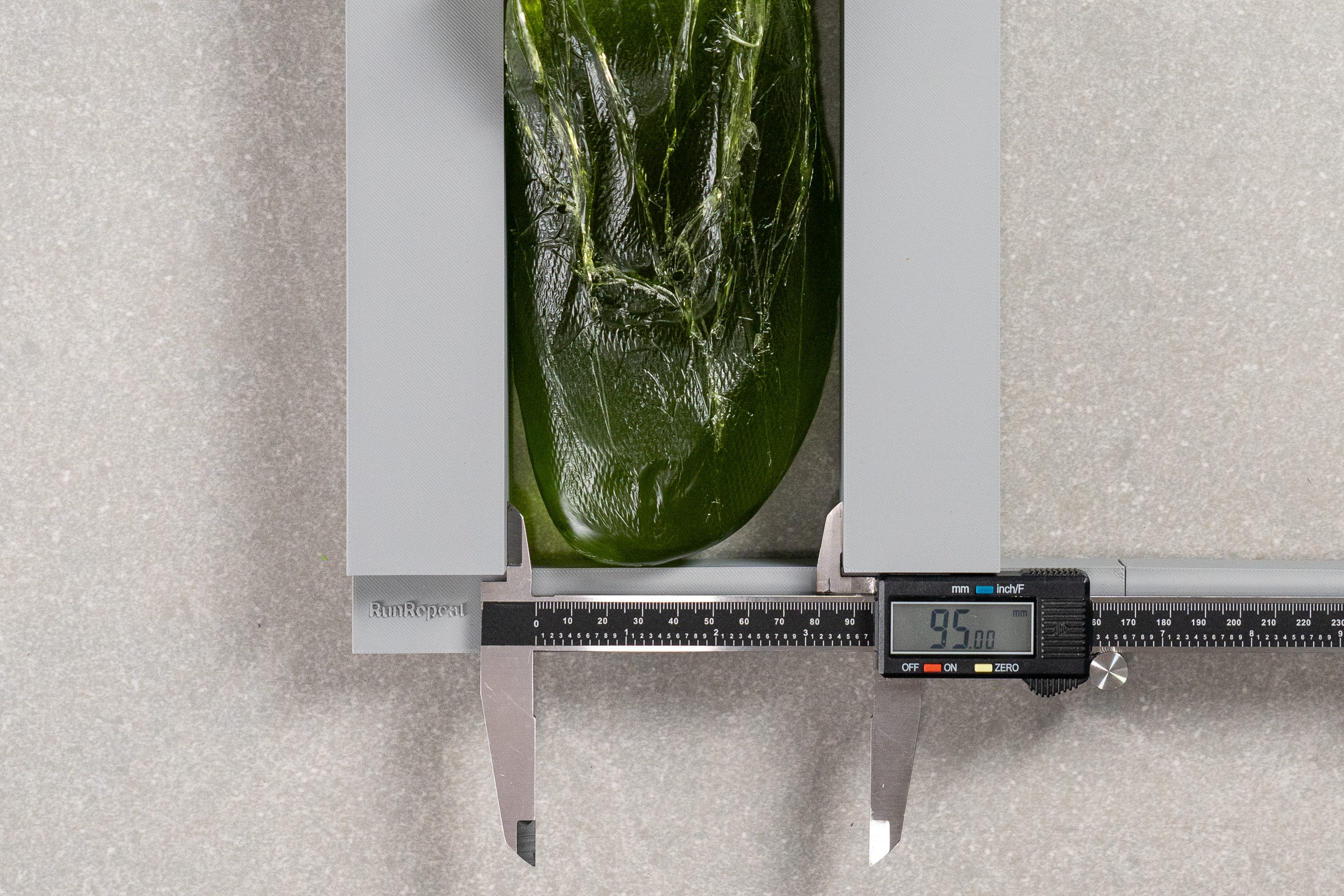
In case you need even more space for wide feet or bunions, this Merrell shoe is also available in wide.
| Accentor 3 | 95.0 mm |
| Average | 94.1 mm |
Toebox width
We could feel and see the Accentor 3's rounded toe shape even before the measurement, so the caliper only confirmed what we already expected - 74.61 mm in the big toe area (slightly wider than average).
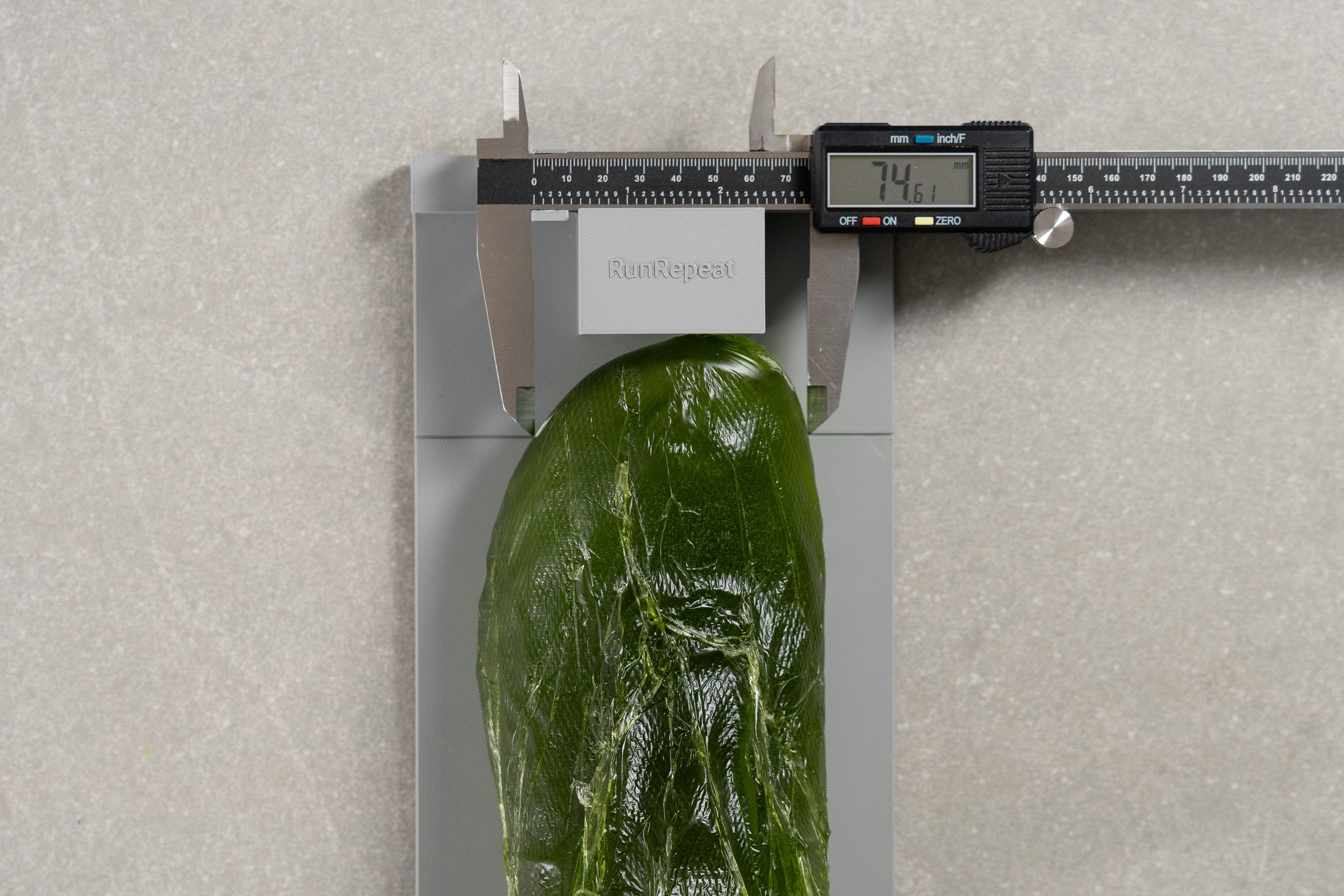
A couple of millimeters may not seem as much but it makes a big difference when it comes to shoe fit.
| Accentor 3 | 74.6 mm |
| Average | 72.5 mm |
Toebox height
Here is where the Accentor's roominess reveals its full potential - the height of the toebox comes in at 32.3 mm! This is one of the biggest measurements we've recorded in this area.
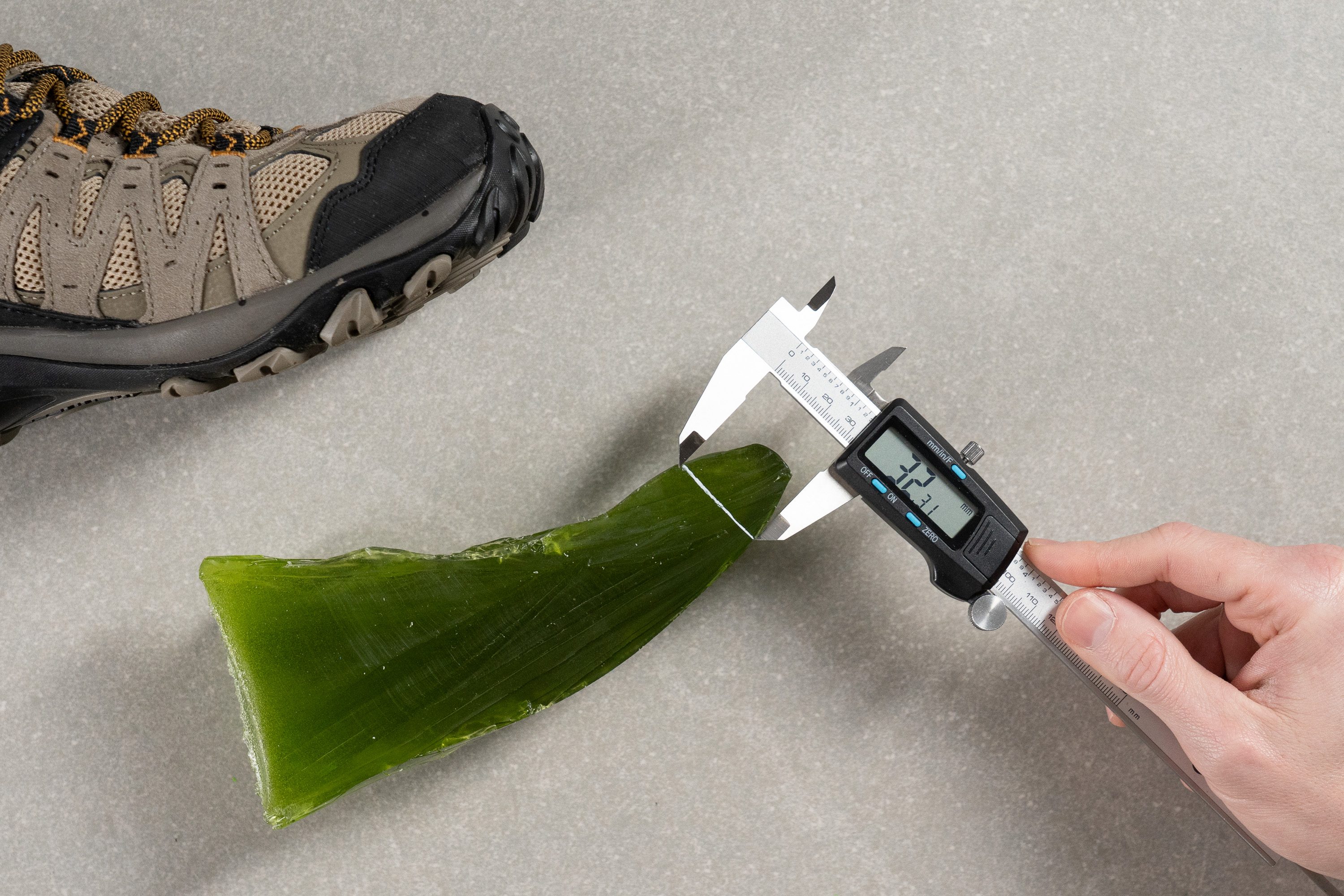
| Accentor 3 | 32.3 mm |
| Average | 28.0 mm |
Traction / Grip
Lug depth
With a caliper reading of 4.3 mm, the Accentor 3's lugs are on par with our current lab average.
This is a good compromise for mixed terrain where you can come across some hard-packed patches, as well as rocks, logs, debris, or even dirt.

| Accentor 3 | 4.3 mm |
| Average | 4.0 mm |
Outsole design
The Accentor's rounded lug shape offers a multi-directional grip but it's not sharp or aggressive enough for steep ascents and descents. Neither does this Merrell shoe have a heel brake to enhance stopping power when going down.
However, the smooth nature of its treading makes the shoe comfortable enough for city streets, parks, and forest boardwalks.

Flexibility / Stiffness
It would be safe to assume that the inclusion of a semi-rigid nylon shank in the midsole would make the Accentor 3 a stiff shoe. However, its clever placement just below the arch means that it's actually quite a pliable shoe; requiring only 14.0N of force to torque by 30 degrees in our flex test.
As such the shoe does little to resist the natural flexion of our foot, a factor that greatly plays into the shoe's relaxed ride. We can, therefore, have our cake and eat it too as the Accentor 3 provides both strong support and luxurious comfort.
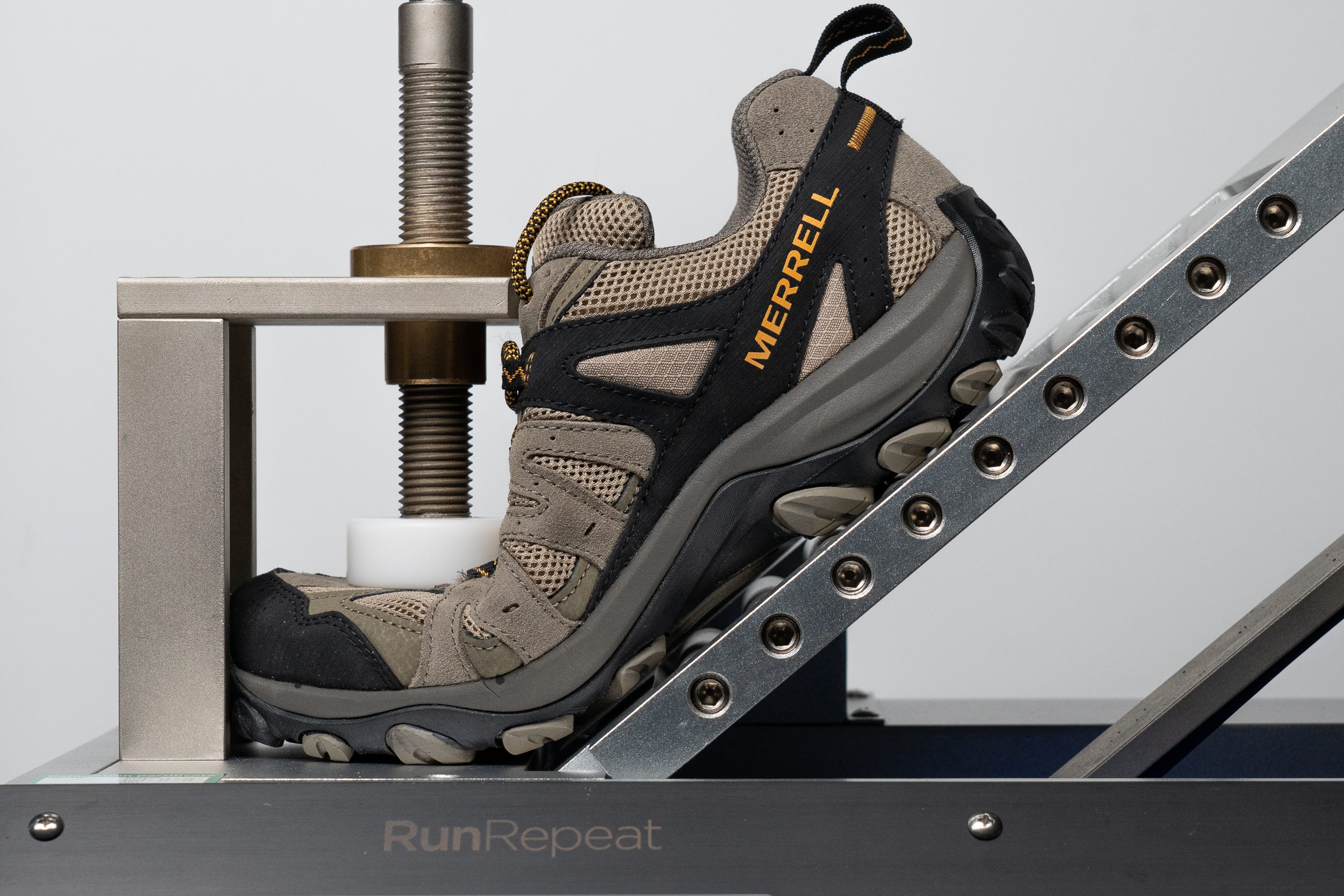
| Accentor 3 | 14.0N |
| Average | 18.3N |
Weight
Which brings us to the weigh-in and the Accentor 3 is certainly quite chunky at 13.9 oz (393g) according to our scale. This isn't devastatingly heavy, however, and isn't too much bulkier than the average hiking shoe and still feels quite comfy underfoot, even at the tail end of longer hikes. That said, a little diet never hurt anyone.
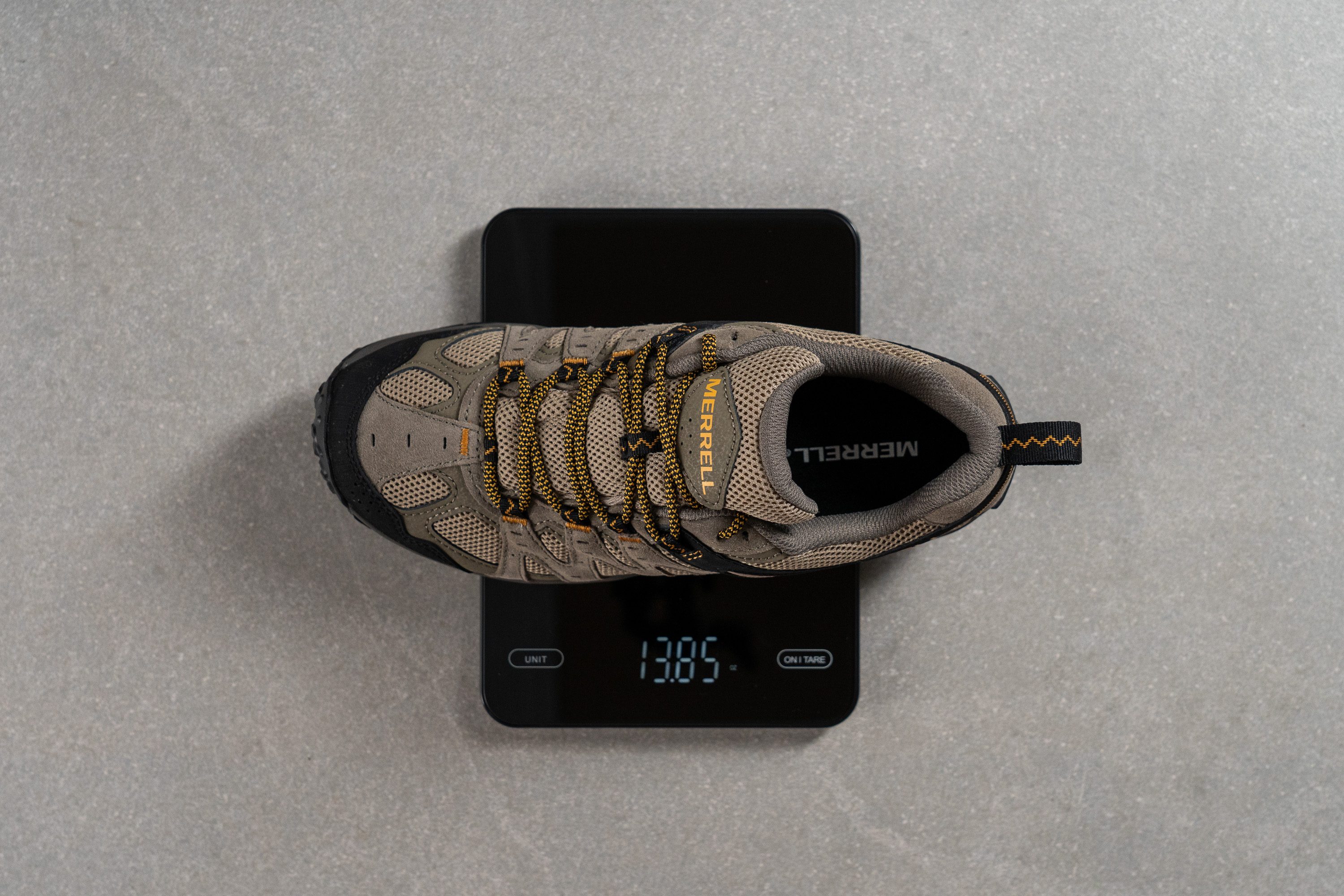
| Accentor 3 | 13.9 oz (393g) |
| Average | 13.4 oz (380g) |
Breathability
We pumped the Accentor 3 full of smoke in order to get a visual idea of how well-ventilated it is. Despite featuring a healthy amount of what looks like porous mesh in its upper constructions, the shoe barely lets a wisp of smoke filter through. This rather surprising result leads us to give the shoe a disappointing 1 out of 5 for breathability. As such, the Accentor 3 traps in heat which makes it much better suited to cold weather hikes.
When inspecting a cross-section of the upper over a backlight, it's clear to see that the mesh isn't nearly as airy as it seems at first glance. The whole upper entirely eclipses our backlight and doesn't let even a ray of light shine through. This goes some ways to explain the shoe's performance in our smoke test.
For further answers, we turn to our trusty microscope which reveals the culprit of this lackluster breathability. Beneath the seemingly well-perforated mesh upper is a more impermeable lining that really prevents heat from escaping the shoe.


| Accentor 3 | 1 |
| Average | 2.4 |
Stability
Lateral stability test
Thanks in great part to the shoe's firm midsole and more grounded forefoot that we touched upon earlier, the Accentor 3 feels incredibly well-planted as we shift our weight from side to side.
There's also a molded nylon shank embedded in the midsole just beneath the arch of our foot. This feels incredibly supportive, especially during longer hikes, and makes the Accentor 3 a good choice for several foot conditions like flat feet or plantar fasciitis.
Torsional rigidity
The Accentor 3 put up a mild level of resistance as we bent and twisted the shoe in our hands, leading us to give it a middle-of-the-road score of 3 out of 5. This means that the shoe is able to twist and contort along with our foot to a certain degree as we navigate difficult terrains while still providing a relatively sturdy landing platform.
| Accentor 3 | 3 |
| Average | 3.7 |
Heel counter stiffness
The heel counter is well-structured and generously padded, making it much more impervious to our manual manipulations. This leads us to give it a stiffness score of 4 out of 5. As such, the shoe mitigates any excessive lateral movements of our heel by holding it in place without putting too much pressure on our tendons. This amount of support in the rearfoot helps prevent us from rolling our ankles as we navigate uneven terrains.
| Accentor 3 | 4 |
| Average | 3.7 |
Midsole width - forefoot
We measured the Accentor 3's midsole to be 108 mm wide at the forefoot which is just shy of our current lab average. This is still more than enough of a platform to push off of securely and surefootedly throughout our test hikes.
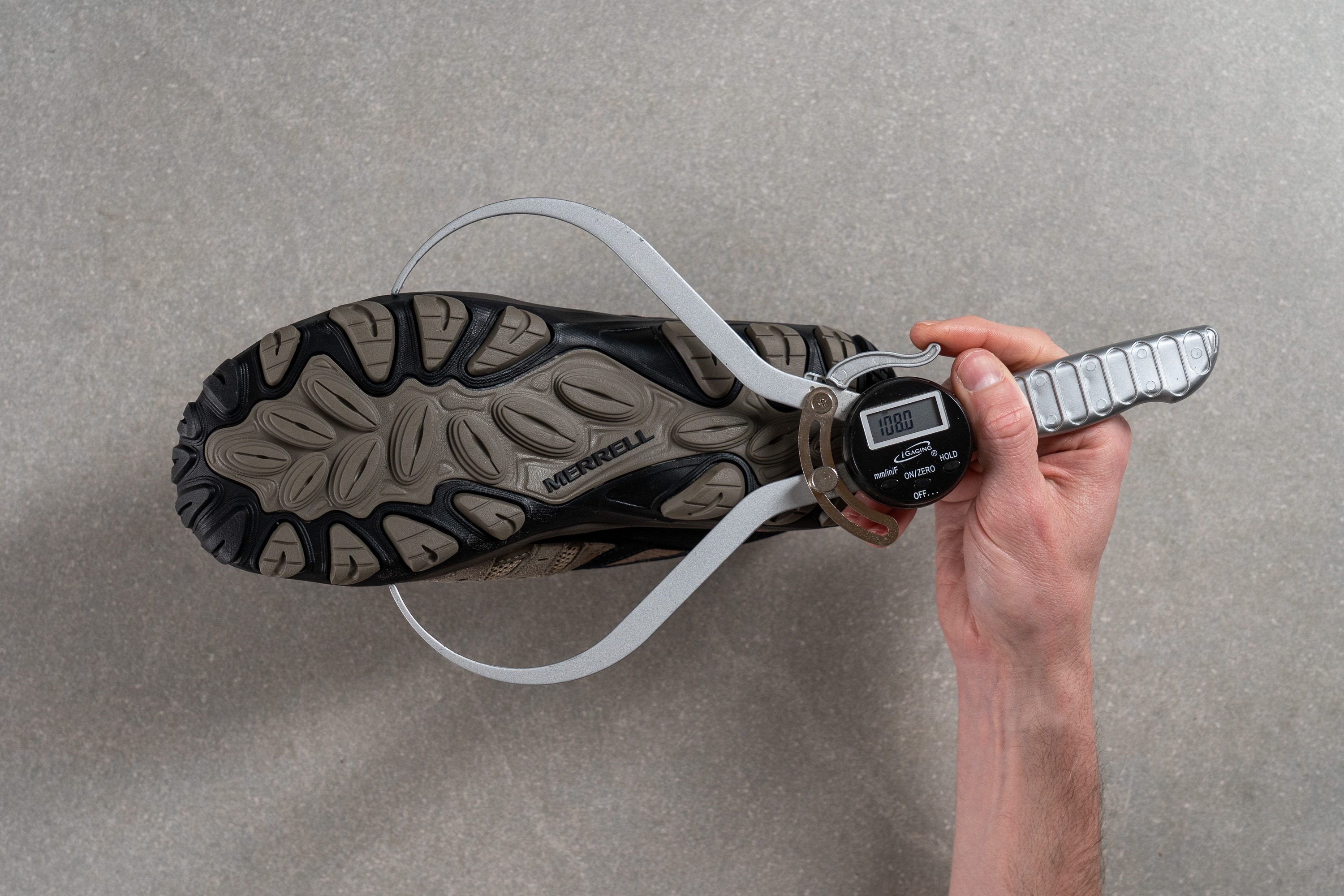
| Accentor 3 | 108.0 mm |
| Average | 111.3 mm |
Midsole width - heel
Back at the heel, the midsole turns out to be significantly narrower than average at only 79.2 mm wide according to our caliper measurements. While this also didn't present us with any trouble as we tested the Accentor 3, we recommend that hikers accustomed to having a broader landing surface check out the Adidas Terrex AX4 as an alternative.
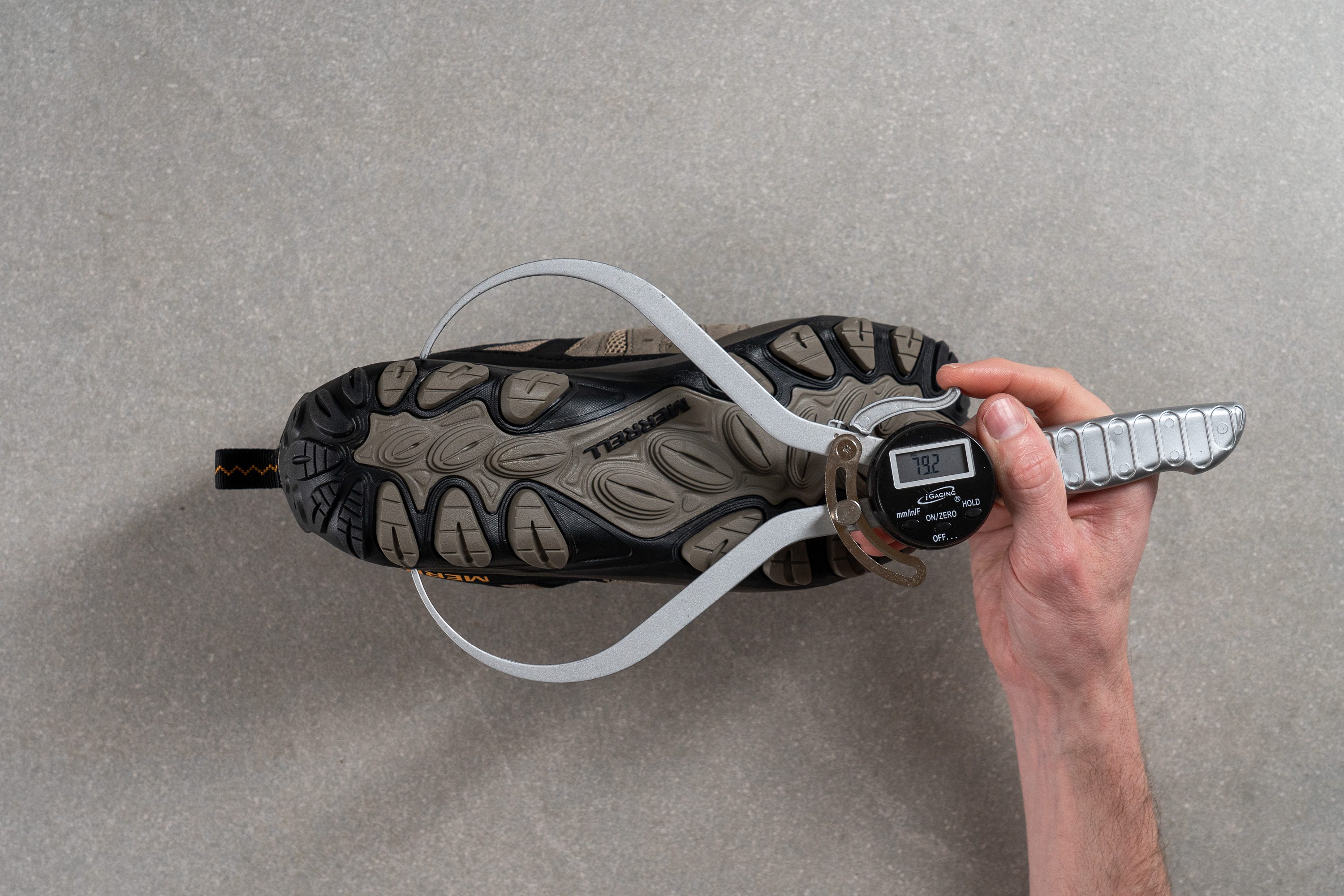
| Accentor 3 | 79.2 mm |
| Average | 87.9 mm |
Durability
Toebox durability
To simulate extreme wear and tear, we fired up our Dremel and subjected the Accentor 3 to its spinning abrasive element. We start with the toebox.
While the test initially seems to go awry for the shoe as our tool kicks up a flurry of suede immediately upon impact. However, after twelve seconds of relentless grinding, we found that we had barely done any damage to the toebox, with only a faintly discolored scuff left behind at the point of contact. This benchmark performance is about as close to perfect as we can expect, earning the Accentor 3 a toebox durability score of 5 out of 5.

The Hoka Anacapa Mid GTX, on the other hand, had its toebox absolutely obliterated by our tool in this same assessment.
| Accentor 3 | 5 |
| Average | 3.7 |
Heel padding durability
Next up to the chopping block is the heel collar which was only subjected to a quick four-second encounter with our Dremel.
As quick as it was, our tool was able to inflict significant damage to the heel collar and managed to mince away the lining material as well as a fair chunk of the padding within. This leads us to give the Accentor 3 a more modest 2 out of 5 in this assessment. It's certainly a weak point of the shoe but should survive the wear and tear of normal use throughout its lifetime.
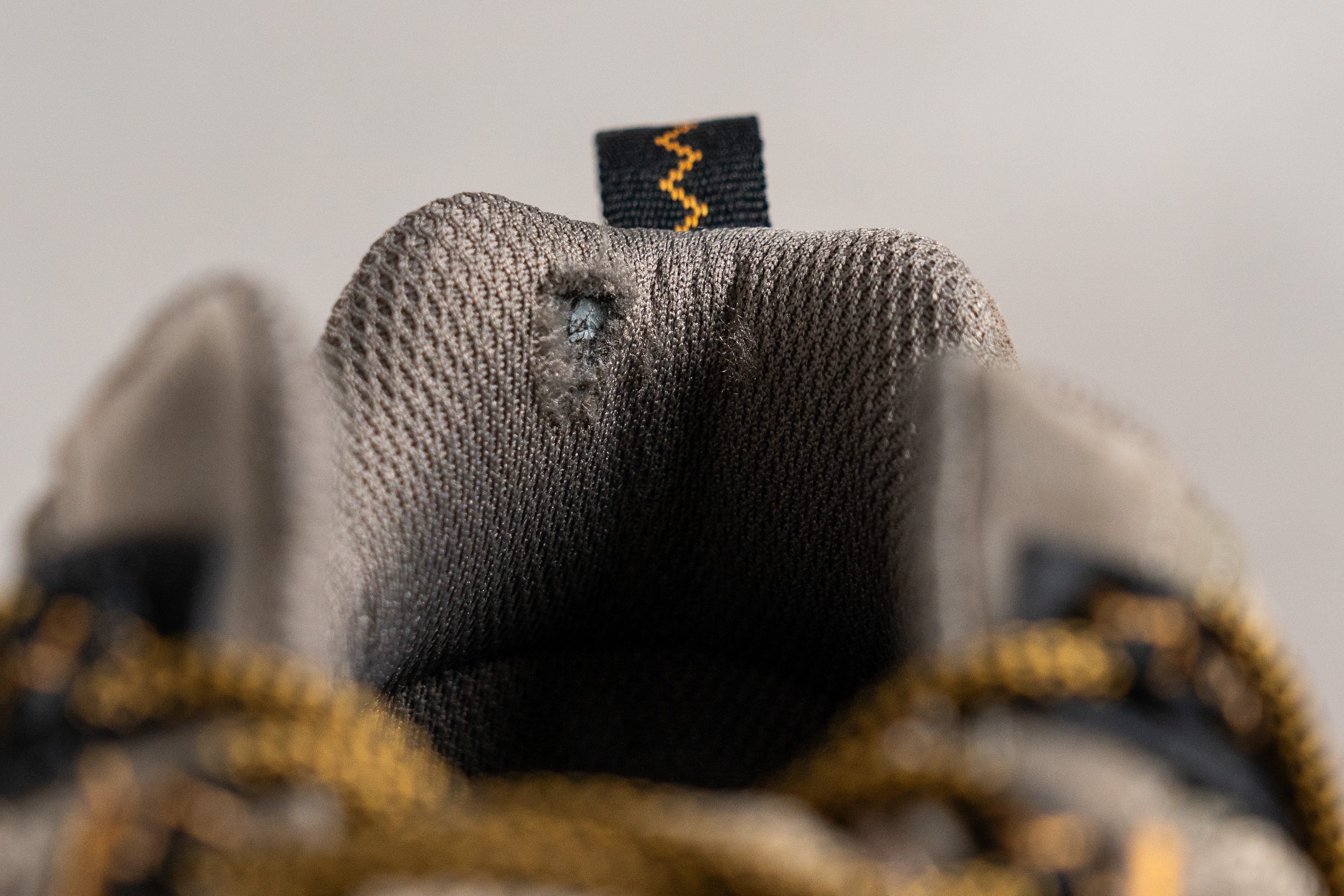
| Accentor 3 | 2 |
| Average | 3 |
Outsole hardness
Pressing our durometer against the Accentor 3's outsole rubber yields a much harder-than-average reading of 94.1 HC. This, in theory, bodes well for its durability as we've found that harder usually means stronger.

| Accentor 3 | 94.1 HC |
| Average | 85.1 HC |
Outsole durability
Increasing the speed to 10K RPM, we optimistically set our Dremel against the outsole for its final face-off against the Accentor 3.
Once the test was over, we were surprised to find that the shoe had lost 1.1 mm of material according to our tire tread gauge which we used to measure the indentation left behind by our tool. This isn't terrible and is about the same as the average hiking boot loses in this same assessment. We just expected better from a shoe with such a hard outsole.

| Accentor 3 | 1.1 mm |
| Average | 1.0 mm |
Outsole thickness
Using our caliper, we measured the outsole to be 3.8 mm thick. When considering the lugs as well, there's over 8 mm of thick rubber making up the Accentor 3's stack. While this allays some of our durability concerns brought about by the last test, we also think that losing some rubber from the outsole would have shaved some weight off this shoe.
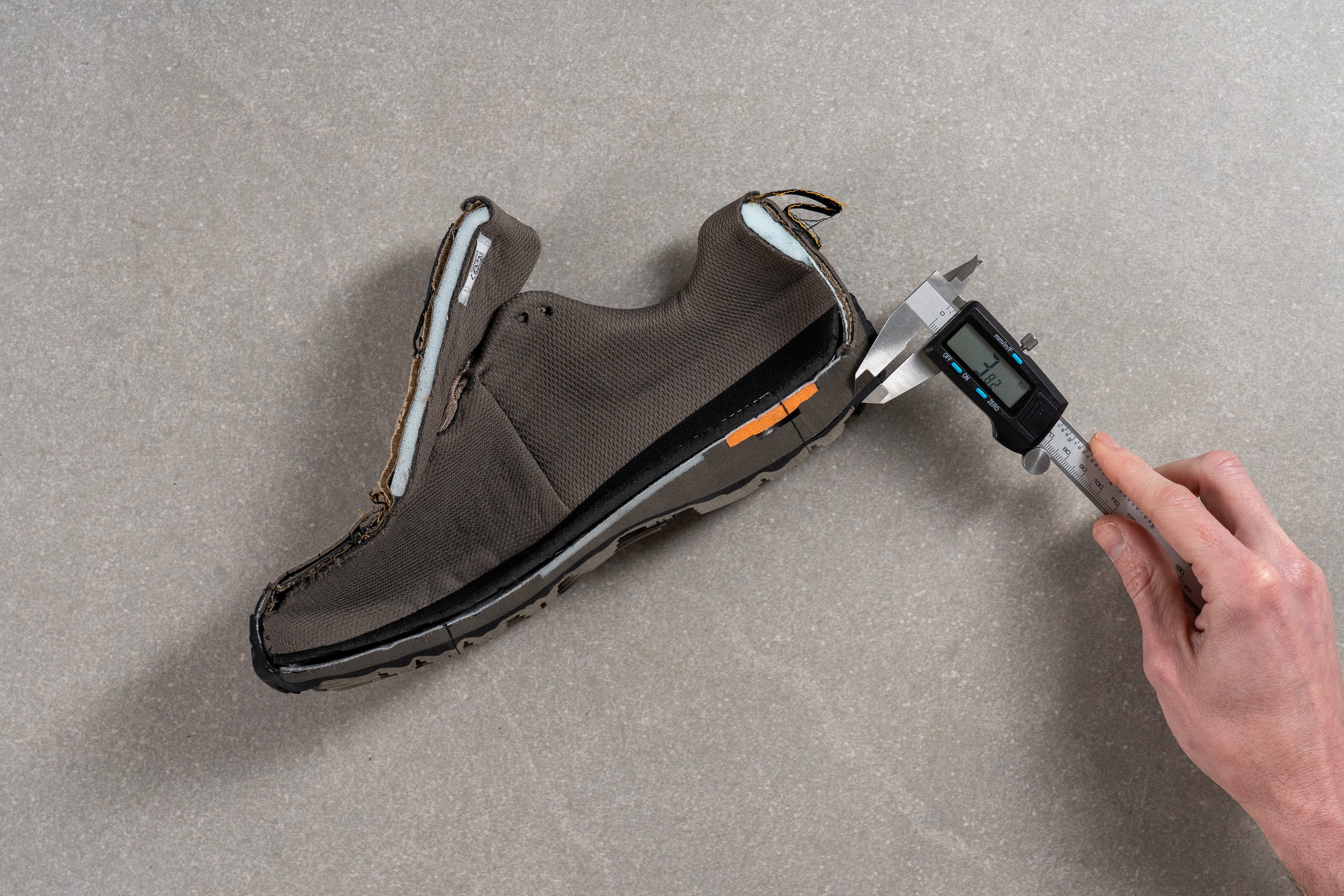
| Accentor 3 | 3.8 mm |
| Average | 2.5 mm |
Misc
Insole thickness
At 4.7 mm thick according to our caliper measurements, the Accentor 3's insole is just shy of our current lab average. That said, it still provides our foot with a nice and soft landing surface within the shoe.
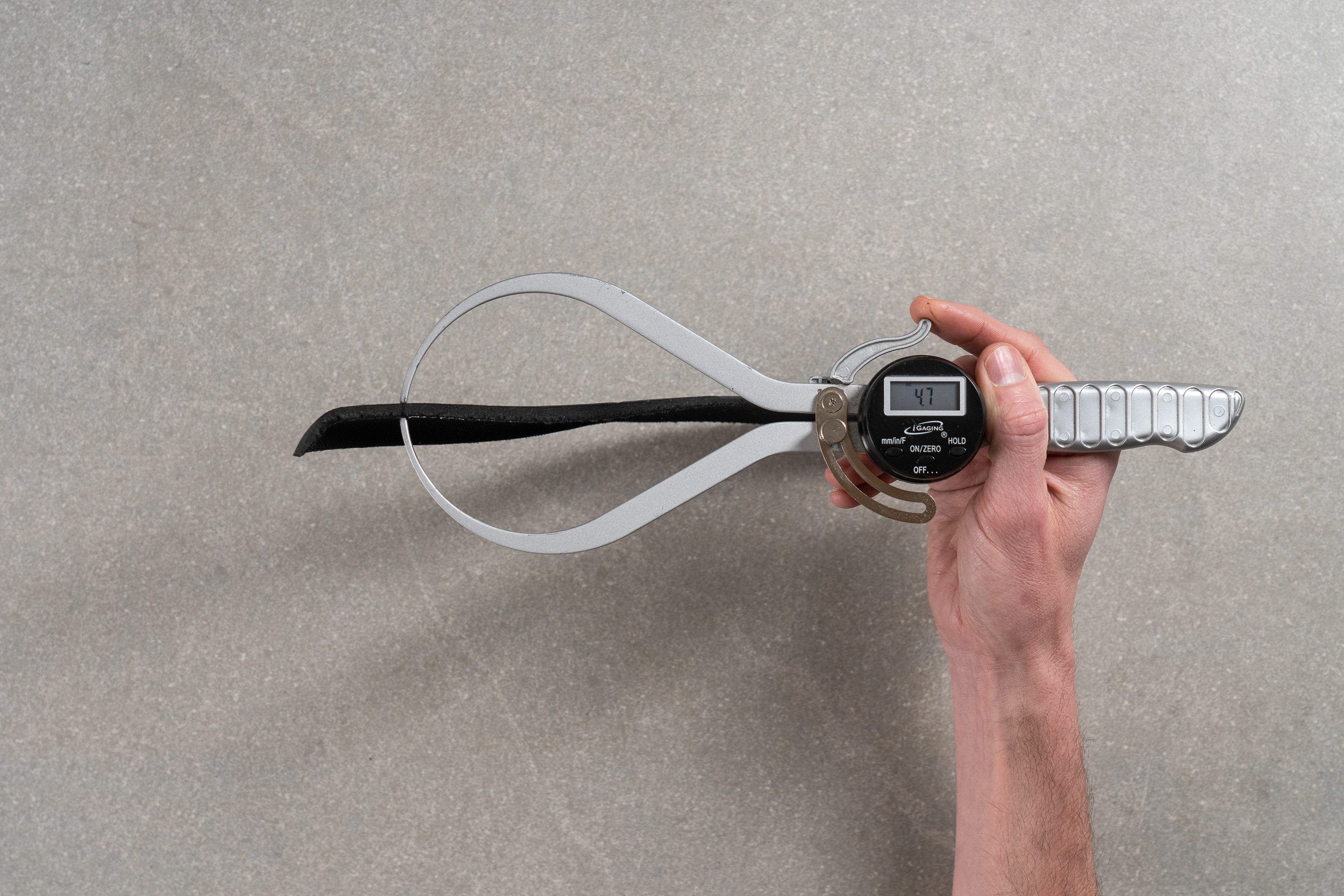
| Accentor 3 | 4.7 mm |
| Average | 5.3 mm |
Removable insole
The insole isn't glued in, so switching it for a custom orthotic or an aftermarket alternative is possible whenever necessary.
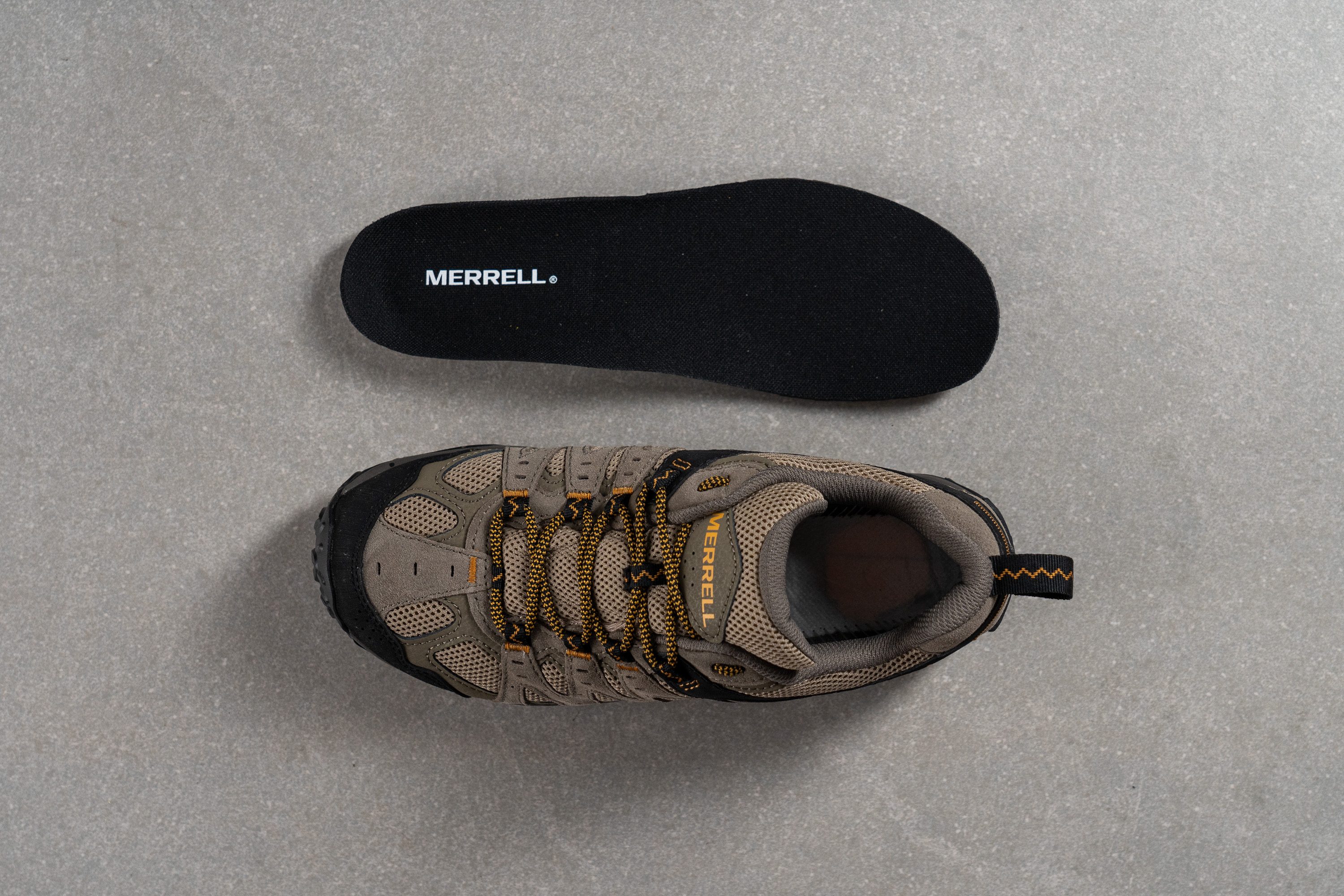
| Accentor 3 | Yes |
Midsole softness in cold (%)
We placed the Accentor 3 in our freezer for twenty minutes to see what effect cold conditions have on the midsole. Once appropriately cooled, we took another durometer reading of the midsole foam and found that it only became 7% firmer. This almost negligible change means that the shoe's already firm cushioning won't be adversely affected by frosty weather.
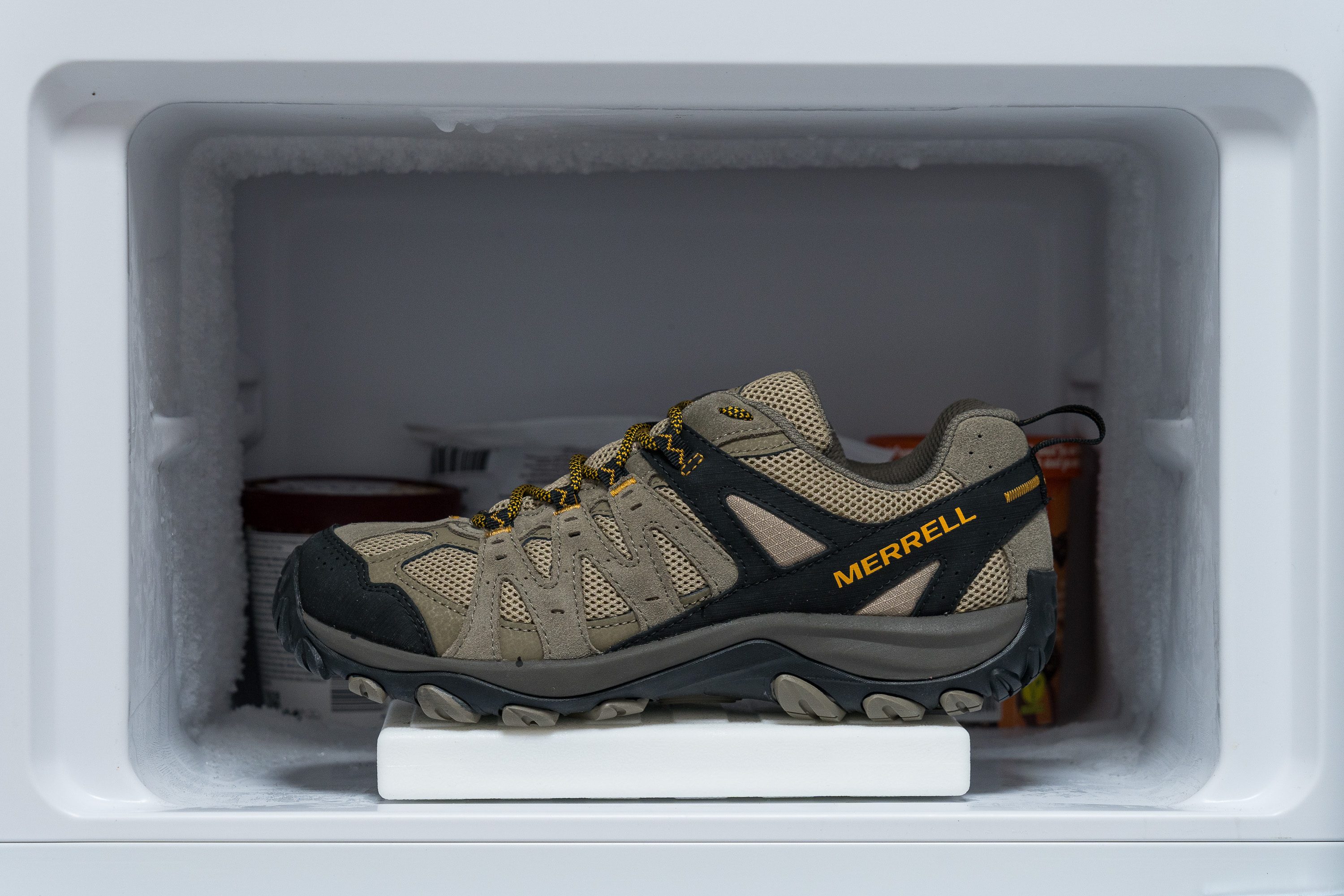
| Accentor 3 | 7% |
| Average | 19% |
Reflective elements
With no reflective elements whatsoever to be found on the shoe, we recommend using additional high-vis gear if ever hiking alongside a dimly-lit road at night.
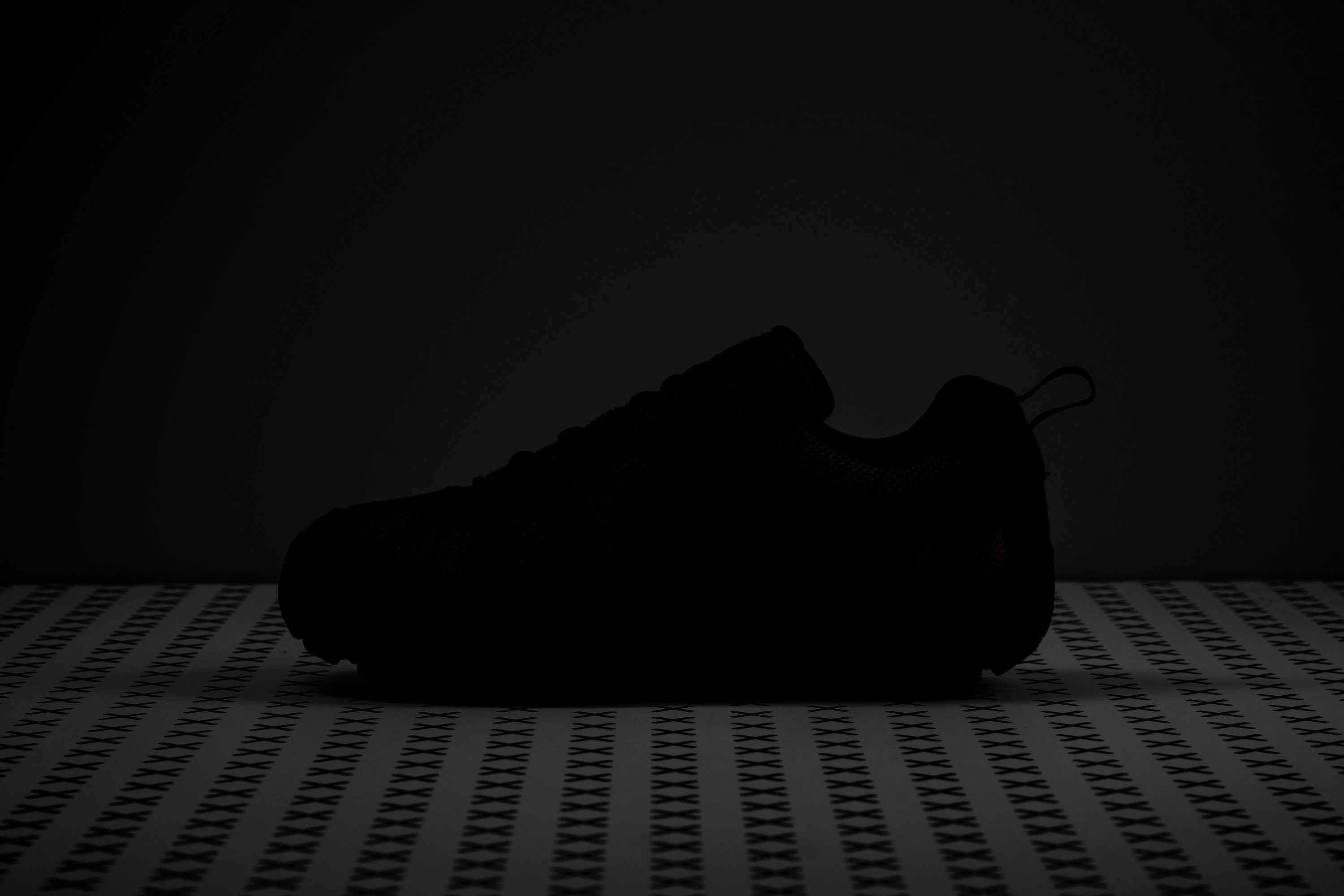
| Accentor 3 | No |
Tongue padding
At 11 mm thick according to our caliper measurements, the Accentor 3's tongue is slightly thicker than our current lab average. This gives us plenty of padding across the instep to protect us from lace bite as well as provide a comfy and secure midfoot lockdown.
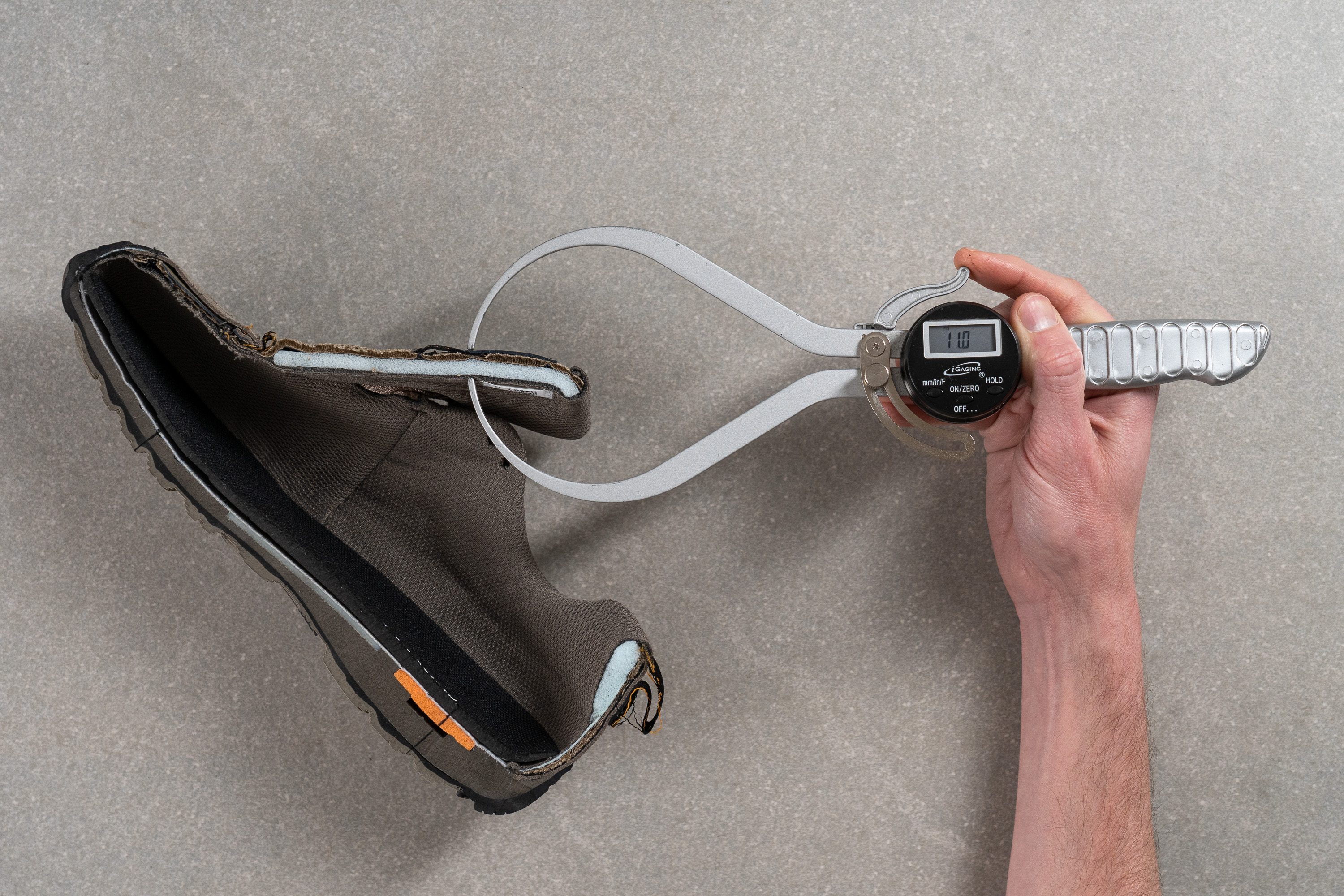
| Accentor 3 | 11.0 mm |
| Average | 10.2 mm |
Tongue: gusset type
Not unusually for a hiking shoe, the Accentor 3's tongue is fully gusseted on both sides. This helps to keep the tongue in place and keep it from sliding around as we walk around, not to mention protecting our feet from any bits of debris that might find their way into the shoe.

| Accentor 3 | Both sides (full) |
Heel tab
There's a little finger loop at the heel of the Accentor 3 that makes sliding the shoe on a little faster and easier.

| Accentor 3 | Finger loop |

